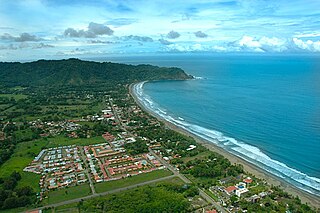
Black sand is sand that is black in color. One type of black sand is a heavy, glossy, partly magnetic mixture of usually fine sands containing minerals such as magnetite, found as part of a placer deposit. Another type of black sand, found on beaches near a volcano, consists of tiny fragments of basalt.

Liberia is a district and the largest city in the Guanacaste Province of Costa Rica, located 215 kilometres (134 mi) northwest of the national capital, San José, which is also in the Guanacaste canton. It is a major center for the country's tourism industry.
Iguanita Wildlife Refuge is a wildlife refuge in the Guanacaste Conservation Area located in the Guanacaste Province of northwestern Costa Rica.

Jacó is a district of the Garabito canton, in the Puntarenas province of Costa Rica. Jacó has a black sand beach that is 4 km (2.5 mi) long and is popular among surfers.

Playa Grande, also known as Salinas, is a beach community on the Pacific coast of Costa Rica just north of Tamarindo. It is located inside the canton of Santa Cruz in Guanacaste Province. Playa Grande has been part of the Parque Nacional Marino Las Baulas since 1990. There are palm trees and lush vegetation all around the beach, which stretches for about 4.5 kilometers. It is part of the Las Baulas National Marine Park, which was established to protect the nesting grounds of endangered leatherback turtles. Playa Grande is one of the major nesting sites for these magnificent creatures, and visitors can witness the nesting and hatching process during the nesting season, which typically occurs from October to March. The main attraction of Playa Grande is its excellent surf breaks. The beach is renowned for its consistent waves, making it a favorite spot for surfers of all levels, from beginners to experienced riders. Playa Grande is an ideal destination for nature lovers, with diverse ecosystems surrounding it. Beyond the beach, you can explore the nearby mangrove forests, take boat tours along the estuaries, or venture into the neighboring national parks, such as Rincon de la Vieja or Santa Rosa, which offer hiking trails, wildlife spotting opportunities, and breathtaking landscapes.

Nosara is a district of the Nicoya canton, in the Guanacaste province of Costa Rica.

Puerto Viejo de Talamanca is a coastal town in Talamanca in Limón Province in southeastern Costa Rica, known simply as Puerto Viejo to locals. The town was originally called Old Harbour until the Costa Rican government institutionalized Spanish as the national language and changed the names of the towns and landmarks in the area from English to Spanish or Native American. Fields became Bri Bri. Bluff became Cahuita. There is another town commonly known as Puerto Viejo in northeastern Costa Rica, Puerto Viejo de Sarapiquí, which can confuse visitors. Buses leaving the same San José station for either of the Puerto Viejos display the same destination, "Puerto Viejo".
The El Salvador national beach soccer team represents El Salvador in international beach soccer competitions and is controlled by the FESFUT, the governing body for football in El Salvador.

Tourism in Costa Rica has been one of the fastest growing economic sectors of the country and by 1995 became the largest foreign exchange earner. Since 1999, tourism has earned more foreign exchange than bananas, pineapples and coffee exports combined. The tourism boom began in 1987, with the number of visitors up from 329,000 in 1988, through 1.03 million in 1999, over 2 million in 2008, to a historical record of 2.66 million foreign visitors in 2015. In 2012, tourism contributed with 12.5% of the country's GDP and it was responsible for 11.7% of direct and indirect employment. In 2009, tourism attracted 17% of foreign direct investment inflows, and 13% in average between 2000 and 2009. In 2010, the tourism industry was responsible for 21.2% of foreign exchange generated by all exports. According to a 2007 report by ECLAC, tourism contributed to a reduction in poverty of 3% in the country.

Cahuita is a district of the Talamanca canton, in the Limón province of Costa Rica. It is located on the Caribbean coast.

Puerto Carrillo is a district of the Hojancha canton, in the Guanacaste province of Costa Rica.

Playas del Coco is one of the oldest beach communities in Guanacaste Province, Costa Rica. This region is also one of the fastest-growing tourism areas in Costa Rica. A popular destination for both local Costa Ricans and visitors from other countries during the traditional holiday seasons, local Costa Ricans refer to Playas del Coco affectionately as "El Coco". At the same time, travelers from outside of Costa Rica use the name "Coco Beach", when mentioning this locale.
Playa Grande may refer to:
Punta Arenas is a city in the far south of Chile.
Playa Flamingo is one of Costa Rica's most popular beaches with fine white sand. It has pristine clear blue waters, lagoons, vegetation and abundance of activities. The Playa Flamingo area offers a wide variety of secluded beaches and lagoons due to the mountain formations reaching into the sea. It features hotels, lodging, luxury homes, entertainment, water, land and leisure activities.
Veintisiete de Abril is a district of the Santa Cruz canton, in the Guanacaste province of Costa Rica.
Karen Cope Charles is a beach volleyball and volleyball player from Costa Rica who played the 2006 and 2010 FIVB indoor World Championships and the 2015 World Championships and the 2016 Summer Olympics in beach volleyball.
Beach volleyball competitions at the 2019 Pan American Games in Lima, Peru were held between July 24 and 30 at the Estadio de Volley de Playa a temporary venue in the San Miguel cluster.









